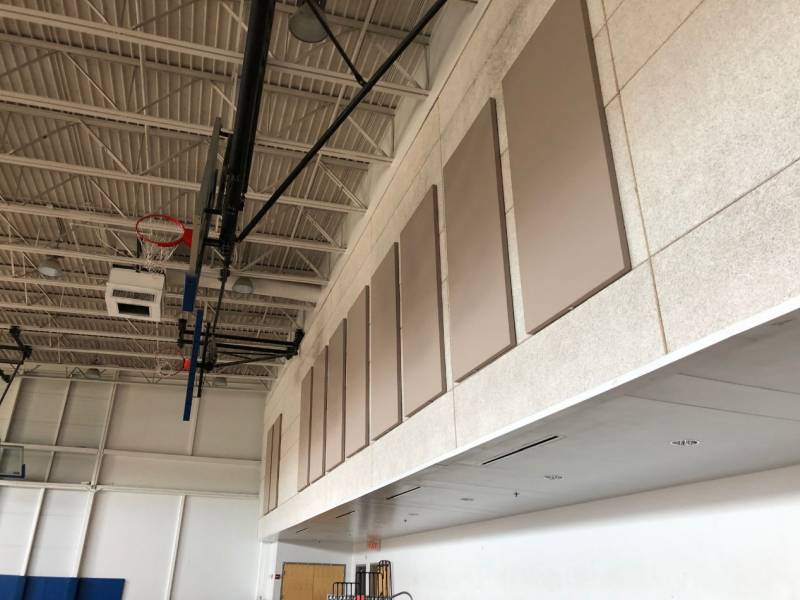Commercial Acoustics was contacted by St Paul’s Episcopal school to solve their time-sensitive gym acoustics problem. Gymnasiums are fundamentally very reverberant spaces due to their hard, parallel surfaces and large volumes. Along with athletics, school gyms are often used as auditoriums and event spaces. This school in particular had scheduled an upcoming fundraising event that featured the performance of a popular New Orleans brass band. Due to their experiences with gym acoustics being very poor during PE and other classes, the administration knew that hosting the brass band would present an issue.
Why is Treating Acoustics in a Gym Important?
An interesting question we often get is “Why do acoustics even matter in a gym?”. It’s a fair question, since most gym users are simply working out or playing a sport, and being able to hear clearly isn’t at the top of the list compared to “Watch your fall” and “Why am I sweating so much?”.
The biggest issue generally arises from the mixed-use of gyms, since many are used in schools and communities to host speaking engagements, to their large capacity and covered space. Because the floors are often hard surfaces, and there are few soft, porous areas, echo buildup becomes a significant issue. Without acoustic treatment, any other events in the gym space will quickly deteriorate and become a major issue.
Best ways to Reduce Gym Echo
The most cost-effective ways to treat gym acoustics are generally using impact-resistant acoustic panels, or installing stretched-fabric wall systems. Both products use breathable acoustic fabrics over dense fiberglass boards to provide high NRC finishes that reduce excess echo in the gym space. Gyms can be left as “lively spaces”, with reverb times in the 1.8-2.2 range without any major concerns or issues. However, without any acoustic treatment, many gyms exceed 3.5-4.0 seconds, which is beyond an acceptable reverberation time limit.

Case Study: Acoustic Panels for the Gym Space
While on site during an initial observation of the space, Commercial Acoustic’s consulting engineer performed a reverberation test (RT60) to determine the as-built reverberation time of the gym. This data was resolved using our Sabins calculation formula to determine the number and size of acoustic panels needed to treat the space, and to ultimately bring down the reverberation time to levels that are adequate for concerts and other school activities. Understanding the precise amount of absorptive material necessary to reduce reverberation is critical for solving gym acoustics.
After discussing the timeframe and budget with the client, Commercial Acoustics was able to fabricate, deliver, and install industrial size acoustic panels within two weeks – just in time for the concert. Many other suppliers presented 4-8 week fabrication lead times, and no ability to perform installation.
The acoustic panels themselves were 4’x8’ in size, comprised of 2” thick dense fiberglass and finished with an acoustical fabric color selected by the client. The NRC value and absorptive characteristics make these the most efficient panels available to mitigate gym acoustics.
Installation consisted of two men operating a 25’ scissor lift, and installing the panel mounts through the existing finish material and directly into the underlying metal studs to ensure a secure and safe assembly.
Although two days were allotted to complete the installation, the team wrapped up within eight hours, and solved the gym acoustics problem before the administration had left for the day. Initial reverberation readings that ranged from 2.1-2.3 seconds were reduced nearly in half to comfortable levels of 1.1-1.5 seconds, leaving the administration confident in hosting the fundraiser.
See other Gym Soundproofing & Acoustic Treatment Case Studies
Gym Acoustics in Summary
Gyms are primarily used for fitness and athletic activities, and therefore, do not need to be optimized acoustic environments. However, many gyms are often used as secondary venues for community events, including speaking engagements and musical performances. In these instances, gyms require acoustic treatment in order to provide an adequate venue for listeners and attendees. Acoustic Treatment should be focused on impact-resistant acoustic panels and acoustic fabric walls, which are durable and will have long functional lives that will not deteriorate in active spaces.

